2008 Seat Ibiza 5D sunroof
[x] Cancel search: sunroofPage 89 of 260
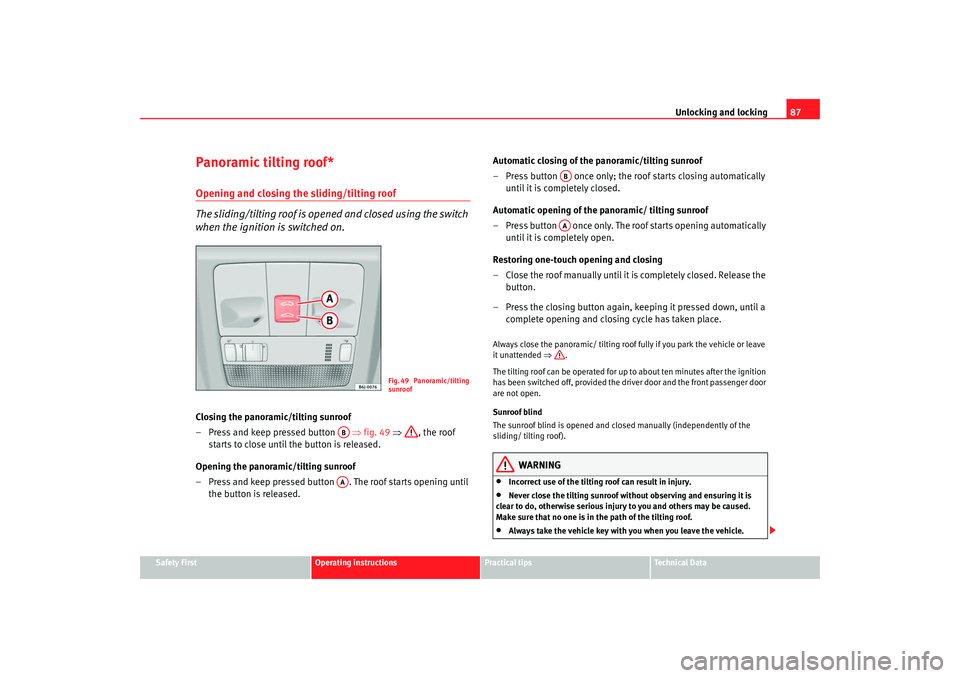
Unlocking and locking87
Safety First
Operating instructions
Practical tips
Te c h n i c a l D a t a
Panoramic tilting roof*Opening and closing the sliding/tilting roof
The sliding/tilting roof is opened and closed using the switch
when the ignition is switched on.Closing the panoramic/tilting sunroof
– Press and keep pressed button ⇒fig. 49 ⇒ , the roof
starts to close until the button is released.
Opening the panoramic/tilting sunroof
– Press and keep pressed button . The roof starts opening until the button is released. Automatic closing of the
panoramic/tilting sunroof
– Press button once only; the roof starts closing automatically until it is completely closed.
Automatic opening of the panoramic/ tilting sunroof
– Press button once only. The roof starts opening automatically until it is completely open.
Restoring one-touch opening and closing
– Close the roof manually until it is completely closed. Release the button.
– Press the closing button again, keeping it pressed down, until a complete opening and closing cycle has taken place.
Always close the panoramic/ tilting roof fully if you park the vehicle or leave
it unattended ⇒.
The tilting roof can be operated for up to about ten minutes after the ignition
has been switched off, provided the dr iver door and the front passenger door
are not open.
Sunroof blind
The sunroof blind is opened and closed manually (independently of the
sliding/ tilting roof).
WARNING
•
Incorrect use of the tilting roof can result in injury.
•
Never close the tilting sunroof with out observing and ensuring it is
clear to do, otherwise serious injury to you and others may be caused.
Make sure that no one is in the path of the tilting roof.
•
Always take the vehicle key with you when you leave the vehicle.
Fig. 49 Panoramic/tilting
sunroof
ABAA
ABAA
Ibiza250_angles Seite 87 Dienstag, 5. August 2008 1:11 13
Page 90 of 260
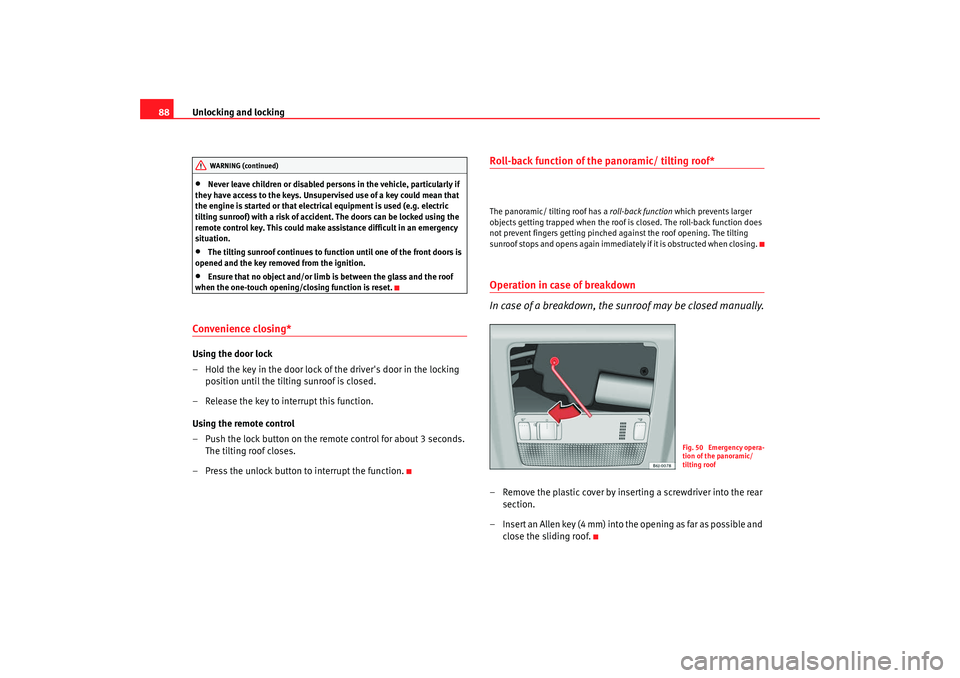
Unlocking and locking
88•
Never leave children or disabled persons in the vehicle, particularly if
they have access to the keys. Unsupervised use of a key could mean that
the engine is started or that electrical equipment is used (e.g. electric
tilting sunroof) with a risk of accide nt. The doors can be locked using the
remote control key. This could make assistance difficult in an emergency
situation.
•
The tilting sunroof continues to function until one of the front doors is
opened and the key removed from the ignition.
•
Ensure that no object and/or limb is between the glass and the roof
when the one-touch opening/closing function is reset.
Convenience closing*Using the door lock
– Hold the key in the door lock of the driver's door in the locking position until the tilting sunroof is closed.
– Release the key to interrupt this function.
Using the remote control
– Push the lock button on the remote control for about 3 seconds. The tilting roof closes.
– Press the unlock button to interrupt the function.
Roll-back function of the panoramic/ tilting roof*The panoramic/ tilting roof has a roll-back function which prevents larger
objects getting trapped when the roof is closed. The roll-back function does
not prevent fingers getting pinched ag ainst the roof opening. The tilting
sunroof stops and opens ag ain immediately if it is obstructed when closing.Operation in case of breakdown
In case of a breakdown, the sunroof may be closed manually.– Remove the plastic cover by inserting a screwdriver into the rear
section.
– Insert an Allen key (4 mm) into the opening as far as possible and close the sliding roof.
WARNING (continued)
Fig. 50 Emergency opera-
tion of the panoramic/
tilting roof
Ibiza250_angles Seite 88 Dienstag, 5. August 2008 1:11 13
Page 119 of 260

Seats and stowage117
Safety First
Operating instructions
Practical tips
Te c h n i c a l D a t a
•
An overloaded boot could mean that the rear stowage tray is not correctly
seated and it may be bent or damaged.
•
If the boot is overloaded, remove the tray.Note
•
Ensure that, when placing items of clothing on the luggage compartment
cover, rear visibility is not reduced.
Roof carrier*Please observe the following points if you intend to carry loads on the roof:•
For safety reasons, only luggage racks and accessories approved by SEAT
should be used.
•
It is imperative to precisely follow the fitting instructions included for the
rack, taking special care when fitting the front bar in the holes designed for
this and the rear bar between the marks on the upper part of the rear door
frame while respecting the correct direction of travel indicated in the installa-
tion manual. Not following these in structions may damage the bodywork.
•
Pay special attention to the tightening torque of the attachment bolts and
check them following a short journey. If necessary, retighten the bolts and
check them at regular intervals.
•
Distribute the load evenly. A maximum load of 40 kg only is permitted for
each roof carrier system support bar, the load must be distributed evenly
along the entire length. However, the maximum load permitted for the entire
roof (including the support system) of 75 kg must not be exceeded nor should
the total weight of the vehicle be exceeded. See the chapter on “Technical
Data”.
•
When transporting heavy or large objects on the roof, any change in the
normal vehicle behaviour due to a change in the centre of gravity or an increased wind resistance must be taken into account. For this reason, a suit-
able speed and driving style must be used.
•
For those vehicles fitted with a sunroof*, ensure that it does not interfere
with the load on the roof carrier system when opened.
Ibiza250_angles Seite 117 Dienstag, 5. August 2008 1:11 13
Page 126 of 260
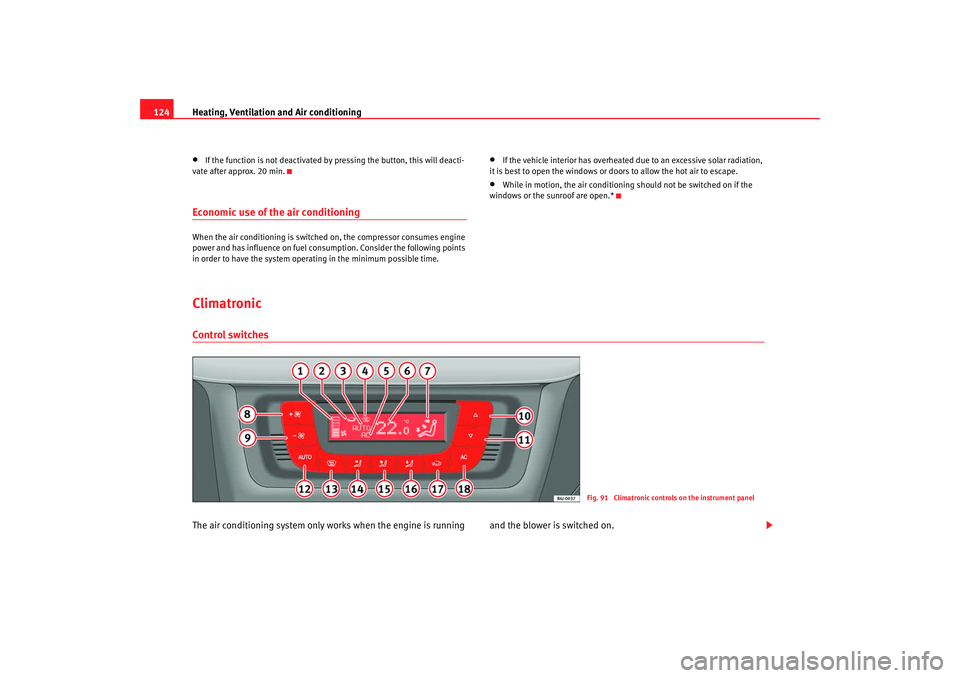
Heating, Ventilation and Air conditioning
124•
If the function is not deactivated by pressing the button, this will deacti-
vate after approx. 20 min.
Economic use of the air conditioningWhen the air conditioning is switched on, the compressor consumes engine
power and has influence on fuel consumption. Consider the following points
in order to have the system operating in the minimum possible time.
•
If the vehicle interior has overheated due to an excessive solar radiation,
it is best to open the windows or doors to allow the hot air to escape.
•
While in motion, the air conditioning should not be switched on if the
windows or the sunroof are open.*
ClimatronicControl switchesThe air conditioning system only works when the engine is running and the blower is switched on.
Fig. 91 Climatronic controls on the instrument panel
Ibiza250_angles Seite 124 Dienstag, 5. August 2008 1:11 13
Page 167 of 260
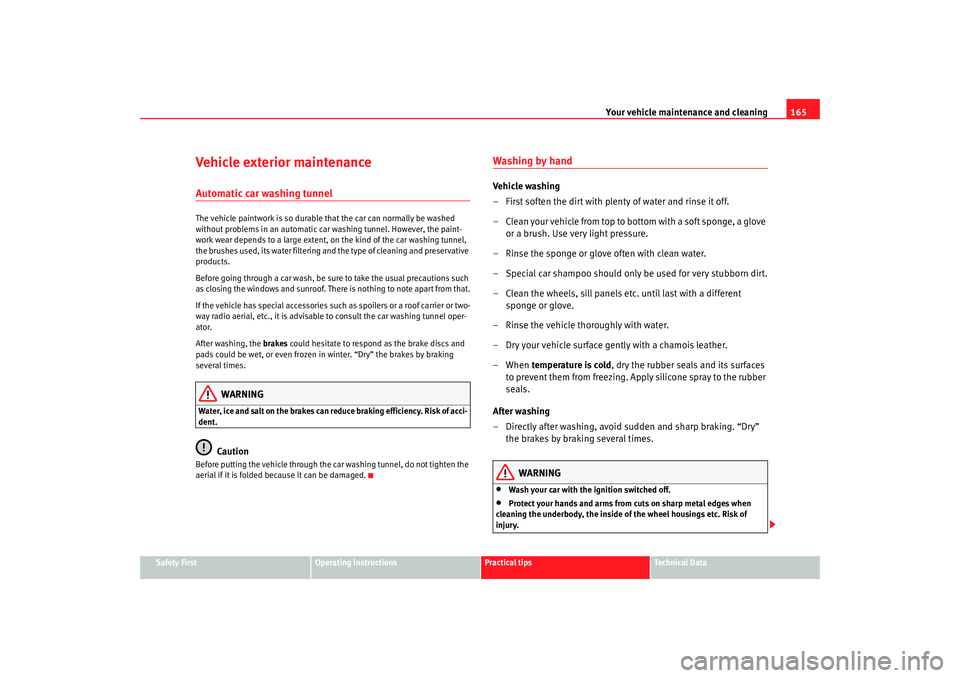
Your vehicle maintenance and cleaning165
Safety First
Operating instructions
Practical tips
Te c h n i c a l D a t a
Vehicle exterior maintenanceAutomatic car washing tunnelThe vehicle paintwork is so durable that the car can normally be washed
without problems in an automatic car washing tunnel. However, the paint-
work wear depends to a large extent, on the kind of the car washing tunnel,
the brushes used, its water filtering and the type of cleaning and preservative
products.
Before going through a car wash, be sure to take the usual precautions such
as closing the windows and sunroof. There is nothing to note apart from that.
If the vehicle has special accessories such as spoilers or a roof carrier or two-
way radio aerial, etc., it is advisable to consult the car washing tunnel oper-
ator.
After washing, the brakes could hesitate to respond as the brake discs and
pads could be wet, or even frozen in winter. “Dry” the brakes by braking
several times.
WARNING
Water, ice and salt on the brakes can reduce braking efficiency. Risk of acci-
dent.
Caution
Before putting the vehicle through the ca r washing tunnel, do not tighten the
aerial if it is folded because it can be damaged.
Washing by handVe hicle washing
– First soften the dirt with plenty of water and rinse it off.
– Clea n yo ur ve hicle fro m to p to bo ttom with a soft spo nge , a g love or a brush. Use very light pressure.
– Rinse the sponge or glove often with clean water.
– Special car shampoo should only be used for very stubborn dirt.
– Clean the wheels, sill panels etc. until last with a different sponge or glove.
– Rinse the vehicle thoroughly with water.
– Dry your vehicle surface gently with a chamois leather.
–When temperature is cold, dry the rubber seals and its surfaces
to prevent them from freezing. Apply silicone spray to the rubber
seals.
After washing
– Directly after washing, avoid sudden and sharp braking. “Dry” the brakes by braking several times.
WARNING
•
Wash your car with the ignition switched off.
•
Protect your hands and arms from cuts on sharp metal edges when
cleaning the underbody, the inside of the wheel housings etc. Risk of
injury.
Ibiza250_angles Seite 165 Dienstag, 5. August 2008 1:11 13
Page 168 of 260
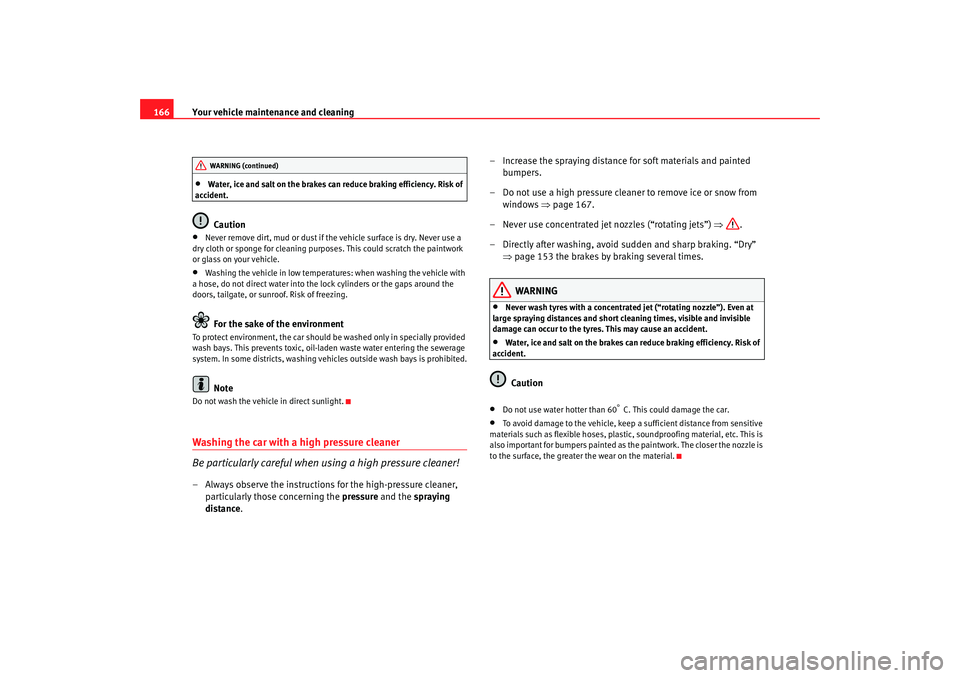
Your vehicle maintenance and cleaning
166•
Water, ice and salt on the brakes can reduce braking efficiency. Risk of
accident.Caution
•
Never remove dirt, mud or dust if the vehicle surface is dry. Never use a
dry cloth or sponge for cleaning purposes. This could scratch the paintwork
or glass on your vehicle.
•
Washing the vehicle in low temperatures: when washing the vehicle with
a hose, do not direct water into the lo ck cylinders or the gaps around the
doors, tailgate, or sunroof. Risk of freezing.For the sake of the environment
To protect environment, the car should be washed only in specially provided
wash bays. This prevents toxic, oil-laden waste water entering the sewerage
system. In some districts, washing vehic les outside wash bays is prohibited.
Note
Do not wash the vehicle in direct sunlight.Washing the car with a high pressure cleaner
Be particularly careful when using a high pressure cleaner!– Always observe the instructions for the high-pressure cleaner,
particularly those concerning the pressure and the spraying
distance . – Increase the spraying distance for soft materials and painted
bumpers.
– Do not use a high pressure cleaner to remove ice or snow from windows ⇒page 167.
– Never use concentrated jet nozzles (“rotating jets”) ⇒.
– Directly after washing, avoid sudden and sharp braking. “Dry” ⇒page 153 the brakes by braking several times.
WARNING
•
Never wash tyres with a concentrated jet (“rotating nozzle”). Even at
large spraying distances and short cleaning times, visible and invisible
damage can occur to the tyres. This may cause an accident.
•
Water, ice and salt on the brakes can reduce braking efficiency. Risk of
accident.Caution
•
Do not use water hotter than 60
° C. This could damage the car.
•
To avoid damage to the vehicle, keep a sufficient distance from sensitive
materials such as flexible hoses, plastic, soundproofing material, etc. This is
also important for bumpers painted as th e paintwork. The closer the nozzle is
to the surface, the greater the wear on the material.
WARNING (continued)
Ibiza250_angles Seite 166 Dienstag, 5. August 2008 1:11 13
Page 257 of 260
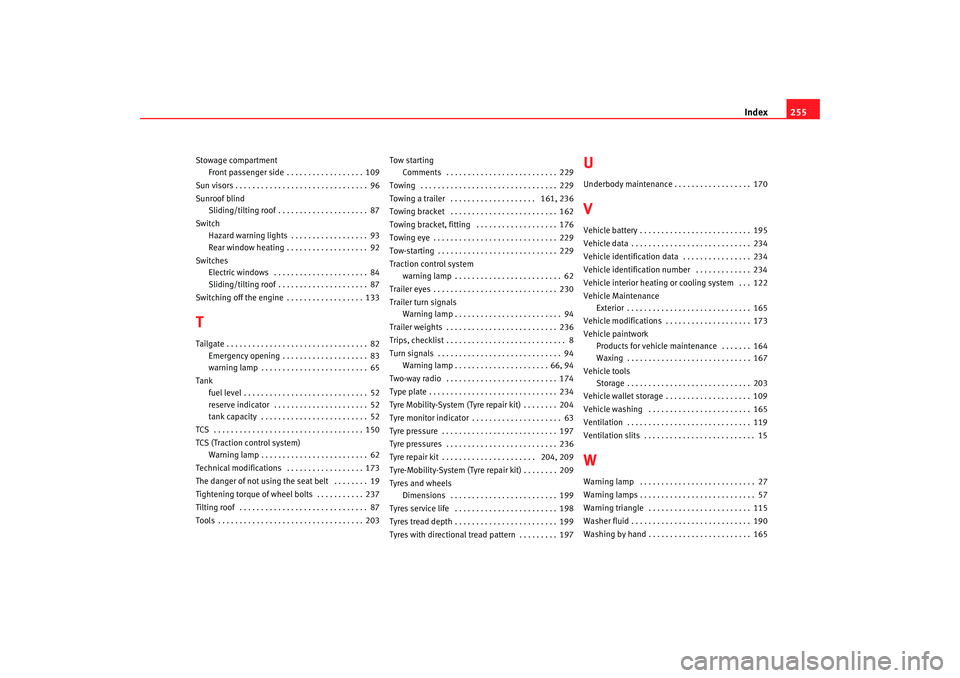
Index255
Stowage compartment
Front passenger side . . . . . . . . . . . . . . . . . . 109
Sun visors . . . . . . . . . . . . . . . . . . . . . . . . . . . . . . . 96
Sunroof blind Sliding/tilting roof . . . . . . . . . . . . . . . . . . . . . 87
Switch Hazard warning lights . . . . . . . . . . . . . . . . . . 93
Rear window heating . . . . . . . . . . . . . . . . . . . 92
Switches Electric windows . . . . . . . . . . . . . . . . . . . . . . 84
Sliding/tilting roof . . . . . . . . . . . . . . . . . . . . . 87
Switching off the engine . . . . . . . . . . . . . . . . . . 133TTailgate . . . . . . . . . . . . . . . . . . . . . . . . . . . . . . . . . 82 Emergency opening . . . . . . . . . . . . . . . . . . . . 83
warning lamp . . . . . . . . . . . . . . . . . . . . . . . . . 65
Tank fuel level . . . . . . . . . . . . . . . . . . . . . . . . . . . . . 52
reserve indicator . . . . . . . . . . . . . . . . . . . . . . 52
tank capacity . . . . . . . . . . . . . . . . . . . . . . . . . 52
TCS . . . . . . . . . . . . . . . . . . . . . . . . . . . . . . . . . . . 150
TCS (Traction control system) Warning lamp . . . . . . . . . . . . . . . . . . . . . . . . . 62
Technical modifications . . . . . . . . . . . . . . . . . . 173
The danger of not using the seat belt . . . . . . . . 19
Tightening torque of wheel bolts . . . . . . . . . . . 237
Tilting roof . . . . . . . . . . . . . . . . . . . . . . . . . . . . . . 87
Tools . . . . . . . . . . . . . . . . . . . . . . . . . . . . . . . . . . 203 Tow starting
Comments . . . . . . . . . . . . . . . . . . . . . . . . . . 229
Towing . . . . . . . . . . . . . . . . . . . . . . . . . . . . . . . . 229
Towing a trailer . . . . . . . . . . . . . . . . . . . . 161, 236
Towing bracket . . . . . . . . . . . . . . . . . . . . . . . . . 162
Towing bracket, fitting . . . . . . . . . . . . . . . . . . . 176
Towing eye . . . . . . . . . . . . . . . . . . . . . . . . . . . . . 229
Tow-starting . . . . . . . . . . . . . . . . . . . . . . . . . . . . 229
Traction control system warning lamp . . . . . . . . . . . . . . . . . . . . . . . . . 62
Trailer eyes . . . . . . . . . . . . . . . . . . . . . . . . . . . . . 230
Trailer turn signals Warning lamp . . . . . . . . . . . . . . . . . . . . . . . . . 94
Trailer weights . . . . . . . . . . . . . . . . . . . . . . . . . . 236
Trips, checklist . . . . . . . . . . . . . . . . . . . . . . . . . . . . 8
Turn signals . . . . . . . . . . . . . . . . . . . . . . . . . . . . . 94 Warning lamp . . . . . . . . . . . . . . . . . . . . . . 66, 94
Two-way radio . . . . . . . . . . . . . . . . . . . . . . . . . . 174
Type plate . . . . . . . . . . . . . . . . . . . . . . . . . . . . . . 234
Tyre Mobility-System (Tyre repair kit) . . . . . . . . 204
Tyre monitor indicator . . . . . . . . . . . . . . . . . . . . . 63
Tyre pressure . . . . . . . . . . . . . . . . . . . . . . . . . . . 197
Tyre pressures . . . . . . . . . . . . . . . . . . . . . . . . . . 236
Tyre repair kit . . . . . . . . . . . . . . . . . . . . . . 204, 209
Tyre-Mobility-System (Tyre repair kit) . . . . . . . . 209
Tyres and wheels Dimensions . . . . . . . . . . . . . . . . . . . . . . . . . 199
Tyres service life . . . . . . . . . . . . . . . . . . . . . . . . 198
Tyres tread depth . . . . . . . . . . . . . . . . . . . . . . . . 199
Tyres with directional tread pattern . . . . . . . . . 197
UUnderbody maintenance . . . . . . . . . . . . . . . . . . 170VVehicle battery . . . . . . . . . . . . . . . . . . . . . . . . . . 195
Vehicle data . . . . . . . . . . . . . . . . . . . . . . . . . . . . 234
Vehicle identification data . . . . . . . . . . . . . . . . 234
Vehicle identification number . . . . . . . . . . . . . 234
Vehicle interior heating or cooling system . . . 122
Vehicle Maintenance Exterior . . . . . . . . . . . . . . . . . . . . . . . . . . . . . 165
Vehicle modifications . . . . . . . . . . . . . . . . . . . . 173
Vehicle paintwork Products for vehicle maintenance . . . . . . . 164
Waxing . . . . . . . . . . . . . . . . . . . . . . . . . . . . . 167
Vehicle tools Storage . . . . . . . . . . . . . . . . . . . . . . . . . . . . . 203
Vehicle wallet storage . . . . . . . . . . . . . . . . . . . . 109
Vehicle washing . . . . . . . . . . . . . . . . . . . . . . . . 165
Ventilation . . . . . . . . . . . . . . . . . . . . . . . . . . . . . 119
Ventilation slits . . . . . . . . . . . . . . . . . . . . . . . . . . 15WWarning lamp . . . . . . . . . . . . . . . . . . . . . . . . . . . 27
Warning lamps . . . . . . . . . . . . . . . . . . . . . . . . . . . 57
Warning triangle . . . . . . . . . . . . . . . . . . . . . . . . 115
Washer fluid . . . . . . . . . . . . . . . . . . . . . . . . . . . . 190
Washing by hand . . . . . . . . . . . . . . . . . . . . . . . . 165
Ibiza250_angles Seite 255 Dienstag, 5. August 2008 1:11 13